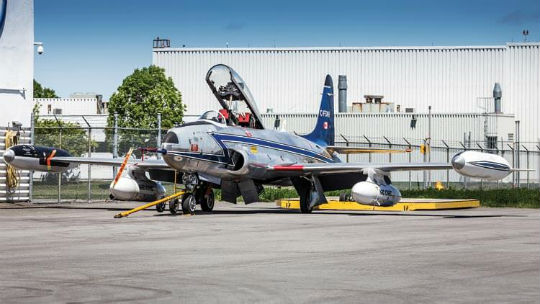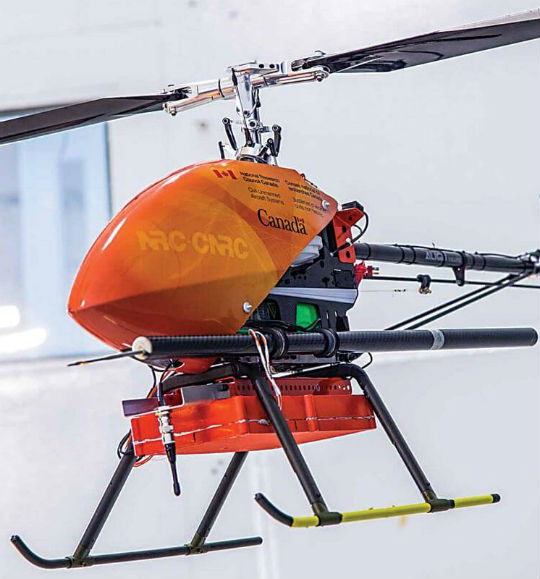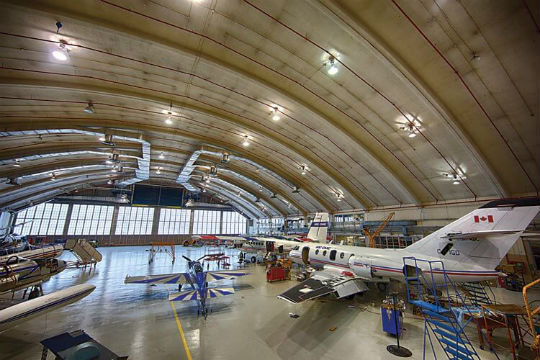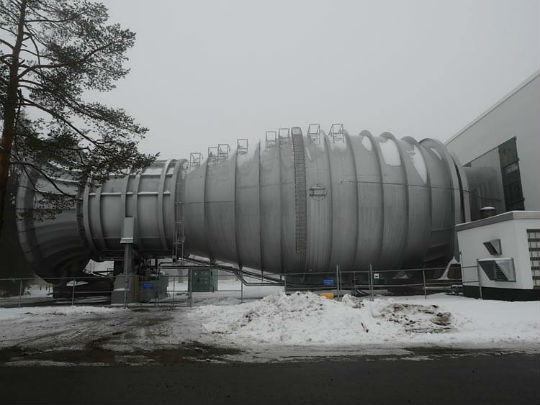The NRC Falcon 20 research aircraft is a robust platform able to support projects requiring high speed and altitude operations. Jan Jasinski Photo
When your work revolves around the intersection between aerospace science and business, you tend to spot opportunities for innovation quickly. Jerzy Komorowski sees one within the federal government’s Industrial and Technological Benefits (ITB) policy.
The general manager of aerospace for the National Research Council of Canada (NRC) has a mandate to support the sector in the creation and adoption of new technology. The ITB policy might encourage aerospace companies to seek out Canadian content for their bids on military contracts, but in strengthening supply chains and promoting Canadian industrial capabilities through products that already exist, are they missing an opportunity?
“How about trying to develop the suppliers of things that do not exist yet and (in turn) create a much more competitive supply chain in Canada?” he asked.
The NRC’s Cabin Comfort and Environment Research facility. It is intended to provide a test space—complete with functional aircraft interior, in-flight entertainment, and flight simulation—for airlines, manufacturers and suppliers to experiment with the integration of new cabin designs and technologies. NRC Image
Finding ways to support innovation is at the heart of Komorowski’s job, and he sees an opportunity for the NRC to “play the role of the catalyst”–through its expertise and research facilities–for industry and government agencies experimenting with technologies.
As an example, he points to a partnership with the Canadian Coast Guard under the NRC’s Civilian Unmanned Aircraft Systems program, to better understand the uses of unmanned aerial systems (UAS) in various complex operational environments.
Announced at the Paris Air Show in June, the partnership is an effort to help the Coast Guard develop a technology roadmap for integrating UAS and other related technologies into its operations. Using a platform and sensor payload provided by ING Robotic Aviation of Ottawa, the program has to date conducted demonstrations for ice surveillance and management and tower monitoring along the St. Lawrence River.
The state-of-the-art centre will include laboratory spaces able to simulate the airport terminal and cabin experiences, room for large-scale mock-ups or fuselages, and a human-rated vibration platform. NRC Image
More than just a demonstration of UAS technology, Komorowski says the project was “a demonstration of a system” that reflects the breadth of expertise the NRC is able to assemble to address complex systems issues that would otherwise be prohibitively expensive for even medium-sized aerospace companies to absorb.
It is also in line with the former Conservative government’s commitment to create a well-funded Aerospace Technology Demonstration Program to support “large-scale technology projects” with high commercialization potential.
AHEAD OF THE GAME
The Coast Guard project was one of several announcements at the Paris Air Show that highlight a range of programs and partnerships that have sprung from a shift in the NRC’s mandate, introduced in May 2013, to “focus on the identified research needs of Canadian business,” with a greater emphasis on supporting “business-led” innovation.
The NRC has participated in NASA’s Access II project, lending its CT-133 research jet to conduct flight tests to study the effects of burning alternative fuels in jet engines on emissions and contrail formations. Jan Jasinski Photo
For many in the aerospace sector, however, the change would have caused only a small ripple.
“Essentially, we were ahead of the game in aerospace,” said Komorowski. “We were (already) extremely well integrated with industry. We measured our relevance to the industry and our value proposition by the level of external funding that our efforts were bringing in.”
In part, that’s due to the strength of a sector that does not get the recognition he feels it deserves for its investments in innovation. But Komorowski also credits his predecessors for managing budget cuts during the dot-com boom of the 1990s, when government attention and money swung to all things IT.
“My predecessors decided: The people are good, the facilities are good, let’s go engage with the outside world more than we have in the past. And let’s find the funding for our projects in the outside world.”
NRC leads technology demonstrations to explore the use of unmanned aerial systems technology in Canadian Coast Guard operations and missions. NRC Photo
That reorientation proved to be a savvy bet. Budgets have more than doubled (to almost $50 million this year) as a result of outside funding. “The measure of the value we provide is that people come back and continually contract work with us,” he said.
Part of the attraction, he believes, is that the aerospace section is able to draw technical expertise and knowledge from anywhere across the NRC, what he calls a “matrix management system.”
“The aerospace industry (now) has access to the aerospace portfolio through a much broader set of competencies. We used to be very siloed in institutes, some institutes kind of unto themselves, (and) by and large it was more difficult for aerospace to access non-aerospace competencies.”
The NRC T-Rex, a platform to test unmanned aircraft technologies. NRC Photo
To illustrate, he describes the Cabin Comfort and Environment Research facility, expected to open in 2016. The facility is intended to provide a test space–complete with functional aircraft interior, in-flight entertainment, and flight simulation–for airlines, manufacturers, and suppliers to experiment with the integration of new cabin designs and technologies and their effects on passengers and air crews.
The state-of-the-art centre will include laboratory spaces able to simulate the airport terminal and cabin experiences, room for large-scale mock-ups or fuselages, and a human-rated vibration platform to test factors that could contribute to passenger comfort or improve the working conditions for air crews, both civilian and military.
NRC’s Flight Research Laboratory in Ottawa maintains a fleet of highly specialized and customizable research aircraft to assist industry with the testing and demonstration of aeronautical technologies in the areas of airborne research, flight mechanics and avionics. NRC Photo
Komorowski said the inspiration for the facility came from observing the work of NRC colleagues in construction research who have developed widely recognized expertise in interior environments. “Whether we sit in a building or on an aircraft, we require the same things: clean air, light, certain noise levels, low vibration,” he said.
“We talked to the industry extensively over the last couple of years to find out their needs. One of our goals is to develop a comfort index to remove some of the subjectivity of what it is the airlines need to provide to the travelling public.”
Testing the performance of anti-icing fluids on a wing section. NRC Photo
He said the centre is a further example of how the NRC collaborates with the aerospace sector to develop areas of research that can be translated into new products. Not only will it provide a mechanism for transferring research findings, it will also offer industry space to “explore trade-offs between cabin attributes” and determine the most cost-effective designs and technologies.
In addition, the facility could alleviate some of the risk involved in introducing new technology and, since airline interiors turn over far more rapidly than airframes, spur a much faster innovation cycle.
NRC’s propulsion and icing wind tunnel, the only facility in the world that can accommodate full-scale, full-speed, cold-temperature tests with fluids. NRC Photo
“We have nurtured competencies that we believe will be relevant to our industry,” he said of the expertise that has been developed in the NRC’s test facilities.
That breadth of capability has attracted global companies like Airbus, Boeing and Rolls Royce, and leading international agencies like the National Aeronautics and Space Administration (NASA). From a business perspective, co-funding and maturing technology with global players opens doors to the Canadian supply chain. But the NRC is also interested in mutual access to research facilities and opportunities.
In May, the NRC renewed an agreement with NASA’s Aeronautics Research Mission Directorate to collaborate on engine icing research. Data from previous research on icing is being used by regulatory bodies to set standards for aircraft engine tolerance of ice crystal ingestion and impact. Komorowski believes the longstanding relationship is evidence that while the NRC operates within a budget that is dwarfed by NASA, it offers niche, leading-edge expertise and facilities of high value to the U.S. agency. In turn, the partnership allows the NRC access to NASA resources.
The NRC Bell 412 is specially configured with on-board research equipment for the development and testing of advanced flight systems and modern cockpit technologies. Mike Reyno Photo
This renewed agreement is but one element of on ongoing collaboration between the two laboratories. In 2014, the NRC participated in NASA’s Access II project, lending its CT-133 research jet to conduct flight tests to study the effects of burning alternative fuels in jet engines on emissions and contrail formations.
The NRC is not a manufacturer of products. In fact, Komorowski is quick to point out that its business is testing, expertise and maturing technologies; while it will create the “pull” for industry, it will not “push” solutions. However, through its research and widening partnerships, it is shaping the technology roadmaps and networks that define key areas of aerospace. And through that effort, it is a catalyst for innovation, a role Komorowski is keen to play.



















